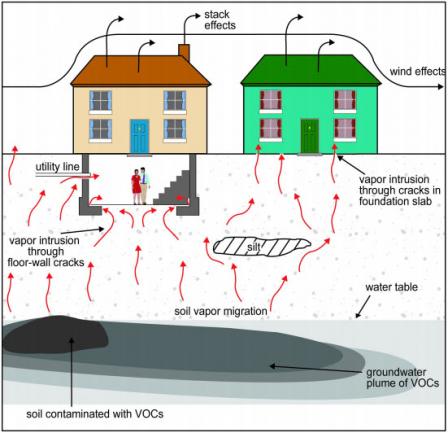What is Vapor Intrusion?
 Figure 1: Migration of Soil Vapors to Indoor Air
Figure 1: Migration of Soil Vapors to Indoor Air
This figure depicts the migration of vapors in soil gas from contaminated soil and groundwater into buildings. Vapors in soil gas are shown to enter buildings through cracks in the foundation and openings for utility lines. Atmospheric conditions and building ventilation are shown to influence soil gas intrusion. Vapor intrusion occurs when there is a migration of vapor-forming chemicals from any subsurface source into an overlying building. Recognition of soil vapor intrusion to buildings and other enclosed spaces occurred in the 1980s with concerns over radon intrusion. Subsequently, there was an increasing awareness that anthropogenic chemicals (e.g., petroleum hydrocarbons and chlorinated solvents) in soil, groundwater, and sewers and drainlines could also pose threats to indoor air quality via the vapor intrusion pathway.
Vapor-forming chemicals may include:
- volatile organic compounds (VOCs), such as trichloroethylene and benzene.
- select semivolatile organic compounds, such as naphthalene.
- elemental mercury.
- some polychlorinated biphenyls and pesticides.
In extreme cases, the vapors may accumulate in dwellings or occupied buildings to levels that may pose:
- near-term safety hazards (e.g., explosion)
- acute health effects
In buildings with lower concentrations of vapor-forming chemicals arising from vapor intrusion, the main concern is whether the chemicals may pose an unacceptable risk of health effects due to long-term (i.e., chronic) exposure to these lower levels.
A complicating factor in evaluating the potential chronic risk from vapor intrusion is the potential presence of some of the same chemicals from emission sources in the building
- household solvents
- gasoline
- cleaners
that may pose, separately or in combination with vapor intrusion, a significant human health risk.
If you have concerns about vapor intrusion or indoor air quality where you live or work, please contact your state health department.
